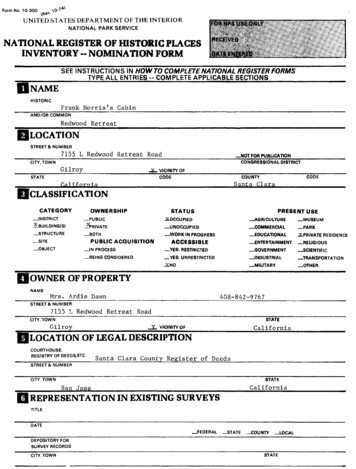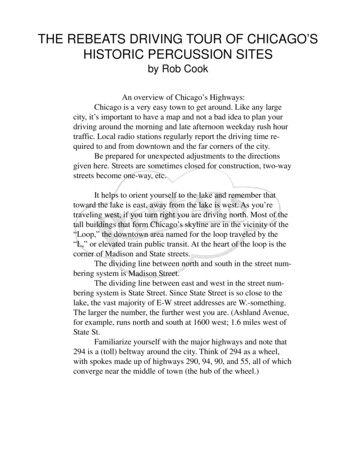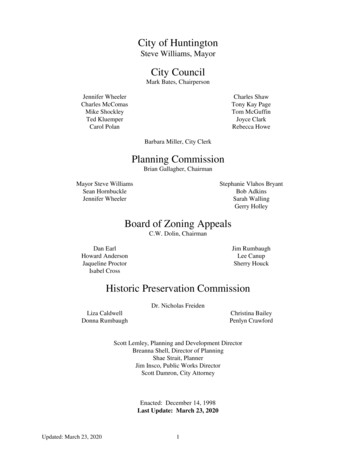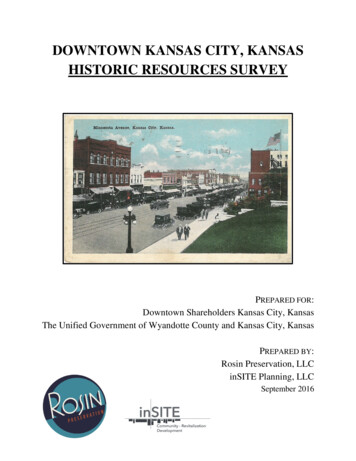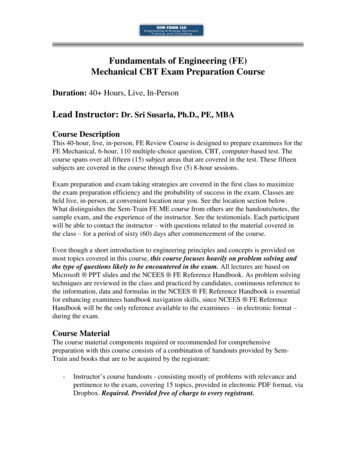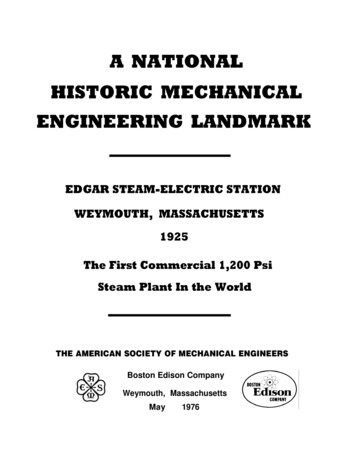
Transcription
A NATIONALHISTORIC MECHANICALENGINEERING LANDMARKEDGAR STEAM-ELECTRIC STATIONWEYMOUTH, MASSACHUSETTS1925The First Commercial 1,200 PsiSteam Plant In the WorldTHE AMERICAN SOCIETY OF MECHANICAL ENGINEERSBoston Edison CompanyWeymouth, MassachusettsMay1976
TABLE OF CONTENTSPageDEDICATION CEREMONY1THE EDGAR STEAM-ELECTRIC STATION3BIOGRAPHY OF IRVING EDWIN MOULTROP6ILLUSTRATIONSPower Station Site - 10-14-22Weymouth Station - Architectural PerspectiveWeymouth Station - Initial InstallationWeymouth Station - Cross SectionPiping System - 1,200 psi Steam Unit1,200 psi Boiler Setting - Longitudinal Section3,150 kw - 1,200 psi Turbine Cross SectionPhotograph - 1,200 psi Steam Pressure TurbinePhotograph - Irving Edwin MoultropREFERENCESACKNOWLEDGMENTS
THE EDGAR STEAM-ELECTRIC STATIONWEYMOUTH, MASSACHUSETTSIn the early 1920's, the Boston Edison Company (then known as theEdison Electric Illuminating Company of Boston) acquired in Weymouth,Massachusetts, a piece of property consisting of 20 acres of land and40 acres of flats on the banks of the Fore River. The area included adeep water harbor for handling large coal barges that could unload directlyat the wharf, and an inexhaustible supply of water for circulating throughthe power plant condensers. The location made it possible to reach suburban territory without running transmission lines through the city ofBoston. 1This was, in short, an ideal site for a new station to provideelectricity for its expanding business.At that time, steam pressures ranged in the neighborhood of 300 psi,while the first plant for 500 psi was reportedly in early stages of design.It would be some time before the development of molybdenum and, later,chrome-molybdenum alloys would permit raising steam temperature appreciably,but the materials then available could be used at higher pressures if someonewould take the lead. Mr. Irving Fdwin Moultrop, then Assistant Superintendent,Construction Bureau of the Edison Electric Illuminating Company of Boston,long active in work of the ASME Boiler Code Committee, guided his companyand the electric utility industry on a major step forward into the higherpressure range of 1,200 psi steam.After studying the gains in efficiency to be had from higher steampressures and temperatures, and confined by the limits of then availablecommercial equipment, it was decided to include in the original developmentat Weymouth one 1,200 psi boiler and turbine acting as a unit, in conjunction-3-
with a 350 psi system consisting of three 350 psi boilers supplying steamat 700 F to a header feeding steam to two 350 psi turbines.2The high-pressure steam at 1,200 psi and 700 F expanded down to 375 psi and 500 Fin the General Electric high-pressure turbine, rated at 3,150 kw. Exhauststeam from this turbine returned to the boiler for reheat to 700 F, thenwas discharged to the 350 psi header for supplying the "normal pressure"(350 psi) turbines for expansion to one inch Hg absolute. The two 350 psiturbines were each rated 32,000 kw.The 1,200 psi steam boiler was a modification of the conventional3Babcock & Wilcox cross drum type. Its heating surface consisted oftwo-inch tubes, 15 feet long, arranged in three passes. The drum, a solidsteel forging 32 feet long, four feet in diameter, and with walls fourinches thick, came from the gun works of the Midvale Steel Company.The first phase of construction at Weymouth went into commercialoperation in December, 1925, establishing a new record for economy byproducing a kilowatthour of electricity from less than one pound ofcoal.4At that time it was common for other "electric light" plants toburn five to ten pounds of coal for one kilowatthour. This record-makinghigh-pressure unit was the first one of its kind operating in the world.Bailey Meter controls were provided for operating the high-pressureboiler.Another "first" was the X-raying of all steel piping used for this1,200-pound steam service, as well as the casings of the turbine itself,to insure a flawless sub-surface. Interestingly, this general method isstandard procedure in engineering specifications today.The station was designed and built by Stone & Webster, Inc., Bostonengineers, under Mr. Moultrop's direction. Although his name appears on- 4 -
all drawings of the project as Assistant Superintendent, Construction Bureauof the Edison Electric Illuminating Company of Boston, very shortly thereafter he became Chief Engineer.After nearly two years of operation, it was reported that no difficultyhad been experienced in handling the high-pressure unit, and the first extension of the station included two more high-pressure (1,400 psi) boilerswith a 10,000 kw high-pressure turbine and a 65,000 kw "normal pressure"(350 psi) main generating unit. Other electric utilities across the countryobserved the experiences at Weymouth with interest, and higher pressurescontinued to be specified from this time forward.The station is named for Charles L. Edgar, an electrical engineer,who studied under Thomas Alva Edison and served as president of BostonEdison for 32 years. During his presidency, Edgar Station set a UnitedStates commercial record for the efficient use of high-pressure steam forelectric generation.4Predating its status as a National Historic Mechanical EngineeringLandmark, Edgar Station has long been a center of community inrerest in theWeymouth area. It was the subject of a picture postcard by the TichnorBros. Company of Boston in the mid-1950's.When the station was fueled by coal, its yards held nearly 300,000tons of coal. The slanting coal chute spanning the access street to theFore River Bridge is a landmark for lost travelers. Today, Edgar Station'scoal yards have been replaced with residual oil storage tanks, althoughthe long-familiar coal chute remains. The days of 12,000-ton colliersdocking and unloading coal at the rate of 800 tons an hour are history.What remains is Edgar Station itself, a monument to the far-sightedthinking of Boston Edison engineers and a station emulated for its efficiencyand reliability.- 5 -
Irving Edwin Moultrop1865-19574Mr. Moultrop was born in Marlborough, Massachusetts,in 1865. Aftergraduating from high school, he worked as an apprentice with the WhittierMachine Company, Roxbury, Massachusetts. In that organization, he rose tothe position of chief draftsman when he resigned to join the Edison Companyin the same capacity in 1892.Meeting the challenges of the growing electric utility business, Mr.Moultrop became a leader in the power field, both in his own organizationwhere he held the position of chief engineer for many years, and in therelated engineering societies. He held various offices in the BostonSection of The American Society of Mechanical Engineers and the EngineeringSocieties of New England. He was active in the work of the ASME Boiler CodeCommittee,5 having helped to formulate the first Boiler Code Committee in1912 and continued over 30 years until his resignation in 1943. Followingthe successful operation of Edgar Station, Mr. Moultrop contributed numerouspapers to engineering societies in the U.S.A., Canada, and the United Kingdom,largely in consideration of the use of higher pressures in steam power plants.He was President of the Engineers Club of Boston from 1925 to 1937, when thisorganization was striving to bring all Boston engineers together with acommon meeting place and library.Because of the pioneering aspects of his career, especially concerningEdgar Station, many honors were bestowed on him, including the Elliot CressonGold Medal of the Franklin Institute of the Commonwealth of Pennsylvania in1930 and an honorary degree of Mechanical Engineer from Stevens Institute ofTechnology in 1931, also the New England Award of the Engineering Societiesof New England 6 in 1942.The citation for this award read as follows:"An engineer, typical of New England Courage and Industry, who byhis own effort attained distinction among his fellows. A pioneerbuilder and operator of high pressure steam electric generatingstations; an executive with large responsibilities, but with timeto give to his profession's technical and social advancement - apublic spirited citizen."- 6 -
Weymouth Station - Initial Installation
Cross-section, Edgar Station, 1925
3150 kw - 1200 psi Turbine Cross Section
Irving E. Moultrop(1865-1957)
REFERENCES1."The Boston Edison's Place in the Electrical Industry," by Charles L.Edgar, President, at the Boston Chamber of Commerce, March 11, 1926.2."High Pressure Steam at Edgar Station," by I. E. Moultrop, ChiefEngineer, the Edison Electric Illuminating Company of Boston, andE. W. Norris, Engineer, Mechanical Division, Stone & Webster, Inc.ASME Transactions FSP-50-30.3."High Pressure Steam at Weymouth," by I. E. Moultrop, AssistantSuperintendent, Construction Bureau, the Edison Electric IlluminatingCompany of Boston, Stone & Webster Journal, Vol. 35, July-December,1924.4.Information provided by the Boston Edison Company.5.Information provided by the ASME National Headquarters.6.Information provided by the Engineering Societies of New England.
Boston.1 This was, in short, an ideal site for a new station to provide electricity for its expanding business. At that time, steam pressures ranged in the neighborhood of 300 psi, while the first plant for 500 psi was reportedly in early stages of design. It would be some time before the development of molybdenum and, later,

